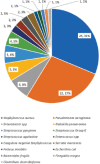Prevalence, Risk Factors and Microbiological Profile of Orthopaedic Surgical Site Infection in North-Eastern Peninsular Malaysia
- PMID: 36589372
- PMCID: PMC9791909
- DOI: 10.5704/MOJ.2211.015
Prevalence, Risk Factors and Microbiological Profile of Orthopaedic Surgical Site Infection in North-Eastern Peninsular Malaysia
Abstract
Introduction: The devastating outcome of orthopaedic surgical site infections (SSI) are largely preventable if its risk factors, causative organisms and antimicrobial susceptibility patterns in the regional area are known.
Materials and methods: We conducted a retrospective study to address the lack of epidemiological and microbiological data on orthopaedic SSI in Malaysia. All the 80 patients diagnosed and treated for microbiologically proven orthopaedic SSIs in a tertiary hospital in Malaysia from April 2015 to March 2019 were included in a 1:2 case control study.
Results: The prevalence of SSI in clean and clean-contaminated surgeries was 1.243%, which is consistent with most of the studies worldwide, but is low compared to other studies done in Malaysia. The most common type of orthopaedics SSI were internal fixation infections (46.25%), superficial SSIs (25.2%) and Prosthetic joint infections (18.75%). Obesity and tobacco use were found to be significant risk factors of orthopaedic SSI. The most common perioperative prophylaxis used was IV cefuroxime. Majority of the cases (86.5%) received prolonged prophylactic antibiotics. The most common causative agent was Staphylococcus aureus (31.25%), followed by Pseudomonas aeruginosa (26.25%) and Enterobacter spp (7.5%). Methicillin-resistant Staphylococcus aureus (MRSA) accounted for 20% of the S. aureus infections. Up to 19.4% of the Gram-negative organisms are multidrug resistant. The higher rate of isolation of organisms resistant to the prophylactic antibiotics being used may be related to the prolonged use of prophylactic antibiotics, which exerted selective pressure for the acquisition of resistant organisms.
Conclusion: Despite its relatively low prevalence in our local institution and worldwide, the prevention of SSI in orthopaedic practice is crucial to avoid morbidity, mortality and high healthcare cost. This may be achieved by control of modifiable risk factors such as obesity and tobacco use, appropriate use of prophylactic antibiotics and implementation of good surgical and infection control practices.
Keywords: causative organisms; orthopaedics surgical site infections; prevalence; risk factors.
© 2022 Malaysian Orthopaedic Association (MOA). All Rights Reserved.
Figures
References
-
- Centers for Disease Control and Prevention. National Healthcare Safety Network. Surgical Site Infection (SSI) Event. 2015. https://apic.org/Resource_/TinyMceFileManager/Academy/ASC_101_resources/... ) (last accessed 13 April 2020)
-
- Zimmerli W, Sendi P. Mandell, Douglas, and Bennett's Principles and Practice of Infectious Diseases. 9th ed. Philadelphia: Elsevier; 2020. Orthopedic implant-associated infections; pp. 1430–42. In: Mandell G, Dolin R, Bennett J, editors.
LinkOut - more resources
Full Text Sources
Miscellaneous



